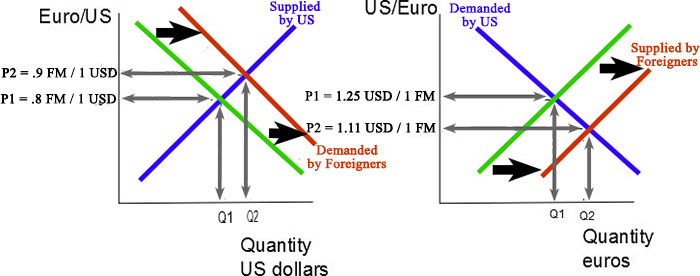Learn
|
Anyone who wants to buy a foreign good or travel to a foreign land must become familiar with the different foreign currencies around the world. Some of the different world currencies include the
Since currencies aren't equal, an exchange rate is established. Exchange rates are stated in terms of one currency to another. For example, 1 US dollar = 120 yen. This ratio tells people that they can exchange 1 US dollar for 120 yen, or trade 120 yen to get one dollar. Read How Exchange Rates Work. Watch the video on page one to learn the basics of determining how much something will cost in a foreign country. You do not have to complete the Interactive Activity. Once you know how the exchange rate between currencies, it is easy to convert price from one currency to another. Assume that the current exchange rate is 1 US dollar = .80 euros.
With an understanding that different currencies exist and they are exchanged at varying rates, it is necessary to learn what causes the exchange rates to vary between different currencies. Like other topics in economics, the value of currencies is determined by supply and demand. Changing the supply or demand of a currency will cause its value to increase or decrease. A basic concept in foreign exchange is that if a currency has increased in value against other currencies, it is said to have appreciated. If one currency has appreciated in value the other currency has depreciated in value. Look at the following example as a review for changes in the value of currency. We will assume that the price level in Europe is increasing and making European goods appear more expensive, relative to the United States. European buyers will want to buy the relatively cheaper goods in the United States, so Europeans will provide Euros to the exchange market. This increase in supply will cause the value of the Euro to depreciate.
At the same time, Europeans will demand US dollars. This will cause the demand for US currency to shift to the right, which causes the value of the dollar to appreciate. All this can be seen by looking specifically at the numerical value of the Euro to the dollar. The euro went from .80 to the dollar to .90 euros to the dollar. It now takes more euros to purchase one dollar than before the shifts, so the US dollar has appreciated. You can also see the same effect on the euro graph. Before the shift it took 1.25 dollars to get one euro while after it took only 1.11 dollars. The euro has depreciated. Now that we know how we convert one currency to another, and what changes the value of a currency, we will now look at what effect the changing value of currency will have on the economy as a whole. Read Exchange Rates and Exchange: How Money Affects Trade to review all that we have learned so far about foreign exchange. The new information will include information about our nation's imports and exports. Engage in the interactive activity for an extensive practice of the concepts important to this lesson. |
